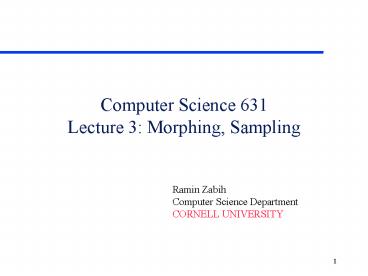Computer Science 631 Lecture 3: Morphing, Sampling PowerPoint PPT Presentation
Title: Computer Science 631 Lecture 3: Morphing, Sampling
1
Computer Science 631Lecture 3 Morphing, Sampling
- Ramin Zabih
- Computer Science Department
- CORNELL UNIVERSITY
2
Outline
- Ray-based coordinates recap
- Bilinear interpolation
- Rotations
- Multiple rays
- Aliasing and sampling
3
Ray-based coordinates
- Compute the position of the pixel X w.r.t. an
oriented ray PQ - Coordinates are A (along PQ) and B (perpendicular
to PQ)
4
Changing units
- The problem is that A and B are in units of
pixels - Need them in percentages of the length of PQ
5
General formula
Note that X (as well as X) is a point, not a
pixel
6
Bilinear interpolation
- We will need to estimate the intensity at a
point, from data which is defined on pixels - Consider a 2-by-2 square of pixels
- Lets see how to interpolate the value at some
point in their midst
Obvious values where x or y are 0 or 1
Want to interpolate linearly in between
7
Fast bilinear interpolation
- The value at the interior point (x,y) is
- To compute this fast
8
Subtlety rotations
- What happens if we interpolate the endpoints?
- In general the segments can get very small
- There is no well-defined solution
- Can interpolate center point, orientation, length
9
Subtlety multiple rays
- Multiple rays are a necessity
- Want to shrink the nose, but not the eyes
- Kais Power Goo is a nice example of this
- Multiple rays will in general give conflicting
ideas about the right intensity - For a given point X, each ray will specify a
point on the source image that Xs intensity
should come from - How to resolve?
10
Weighting with distance
- The closer X is to the ray PQ, the more PQs
opinion matters - We take a weighted average
- Let Xi be the point that the ith ray believes
that Xs intensity should come from
11
How to do the weighting?
- Beier and Neely use
- dist is the distance from X to this ray
- a,b,p are constants that tune the function
- If a0, points near the line matter are hugely
influenced by that line - If p0, line length doesnt matter
- b determines how fast weight decays with distance
- In practice, p in in 0,1, b in .5,2
12
Subtlety (and next topic) aliasing
- Suppose that we shrink the input image
- We will only examine a subset of input pixels!
- This can introduce an artifact called aliasing
- Patterns in the output that arent in the input
- Example output is 1/2 width of input image
- Destination scanning will ignore half the input
pixels! - Only examine input pixels where x is even
- Suppose that the input is a checkerboard, where
every square is a single pixel
13
Mutilating a checkerboard
14
Aliasing example
15
Aliasing issues
- These issues can arise any time the image size
changes (which is almost always) - When is aliasing not a problem?
- If the input image changes slowly relative to
how much we shrink it, this isnt a problem - Consider a black image, or a uniform ramp
- Or we can blur the image (well cover this)
16
How to think about aliasing
- There is a lot of material on this topic
- DSP courses, especially EE302 or EE425
- Any computer graphics course
- Basic idea represent an image as a sum of parts
that change slowly and parts that change fast - This is a change of basis from the standard
representation in terms of pixels
17
Frequency decomposition of an image
- An image can be described in several ways
- So far, in terms of pixels ( spatial domain)
- The frequency decomposition is very useful
- Low-frequency components change slowly
- High-frequency components change rapidly
- If the image has no (little) high-frequency
components, then aliasing is not a problem
18
Why use the frequency domain?
- By describing an image in terms of the frequency
domain, many things become clear - The image formation process itself removes really
high-frequency components - What happens when we take a picture of a
checkerboard where a pixel contains 100 squares? - Many image operations are naturally viewed in
terms of their effects on various frequency
components - Local averaging removes high-frequency components
- Image compression is best viewed in this way
19
Choice of basis
- The canonical way to describe the frequency of an
image is in terms of its Fourier transform - This involves a number of issues that we dont
have time to cover in depth - Instead, we will use a Wavelet representation
called the Haar basis - Same basic idea, but easier and more intuitive
- For example, our basis vectors will be mostly 0
- By contrast, the Fourier basis is sine waves
20
Image representations
- Consider a 1-D image (signal) with four elements
I 9 7 3 5 - Spatial representation
- I 91 0 0 070 1 0 030 0 1 050 0 0
1 - The basis elements are 1-D (in this case)
vectors, each with a single 1 - What are they called for an image?
21
Wavelets and DC components
- Our basis vectors will have a scale, which
intuitively means how many non-zero elements - To begin with, we will subtract the average value
of I, which is 6 in our example - I - 6 3 1 -3 -1 I 61 1 1 1 3 1 -3
-1 - 1 1 1 1 is our first (dull) new basis
- No zeros, so coarsest possible scale
- The average value of an image is referred to as
its DC component, others are AC components

